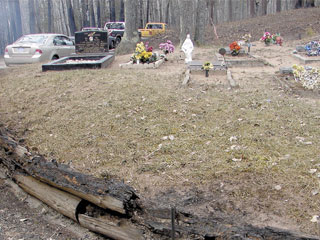Bittersweet ending to planting of 12,000 trees
Forest fire breaks out hours after final plants in ground
By Greg Peterson, Today correspondent

Photos courtesy Susan LaFernier/Keweenaw Bay Indian Community
One of two northern Michigan forest fires fanned by 40 mph winds May 20 destroyed hundreds of acres of Keweenaw Bay Indian Community trees and 45 sacred spirit houses at Pinery Cemetery.
MARQUETTE, Mich. – Several American Indian tribes helped plant 12,000
trees across northern Michigan in May during the interfaith EarthKeeper Tree
Project including members of an Ojibwa tribe who bravely tried to save 45
sacred spirit houses from being destroyed as two huge forest fires broke out
just hours after planting the last seedlings.
Thousands of EarthKeeper volunteers from more than 100 churches and temples
planted more than 12,000 white spruce and red pine seedlings measuring 12 to
16 inches tall in all 15 Upper Peninsula counties and Minocqua, Wis., said
Catholic EarthKeeper Kyra Fillmore of Marquette, the project distribution
coordinator, adding the teams hope “the trees grow strong and tall.”
The EarthKeeper team includes 10 faith traditions with more than 150
participating churches/temples (Catholic, Episcopal, Lutheran, Presbyterian,
United Methodist Church, Unitarian Universalist, Baha’i, Jewish, Zen Buddist,
Quakers), plus the nonprofits Superior Watershed Partnership and Cedar Tree
Institute, as well as the Northern Michigan University EarthKeeper Student
Team.
Hours after the last of 12,000 trees were planted, a forest fire on the
Keweenaw Bay Indian Community reservation jumped the road ravaging a sacred
cemetery.
In an ironic twist, two huge forest fires erupted May 20 destroying
thousands of trees only hours after the final ones were planted by members
of the Keweenaw Bay Indian Community.
Fanned by 40 mile per hour winds with gusts to 60 mph, one inferno in Baraga
County rampaged across hundreds of acres of KBIC forest land and into a
tribal cemetery used by members of the Zeba Indian Mission United Methodist
Church.

Hours after the
last of 12,000 trees were planted, a forest fire on the Keweenaw Bay Indian
Community reservation jumped the road ravaging a sacred cemetery.
Susan J. LaFernier, church member and KBIC vice president, said the fire
destroyed 45 sacred spirit houses at the KBIC Pinery Cemetery that has been
managed by the Zeba Indian Mission for nearly 200 years.
When the blaze roared across the remote cemetery surrounded by woods
LaFernier was raking and preparing to bury her cousin hours after planting
the last of the trees.
She and tribal men, who were preparing the grave, jumped into action using
anything they could to prevent the fire from reaching the spirit houses;
fortunately dozens were saved.
“We are very protective of the cemetery,” said LaFernier,
great-great-granddaughter of a Methodist missionary during the 1800s.
Her mother, father, brother and many other family and friends are buried at
the cemetery.
“I tried to put out a small fire there to save the houses and cemetery but
was not able; it had already jumped across the road,” said LaFernier, adding
the exact number of trees burned is not known, but could be in the tens of
thousands.
A larger forest fire about 60 miles east in neighboring Marquette County
destroyed 30 buildings including 21 homes. No deaths or serious injuries
were reported.
Lafernier said even though 45 spirit houses were burned, the blaze could
have been worse. “We had just raked the leaves away for the Memorial Day
services.”
Only 10 days before the fire about 200 seedlings were passed out during
Mother’s Day church services at three Methodist churches in Baraga County
that share the same pastor.
As the churches planted “trees to nurture the earth” they “honored Mother
Earth for her nurturing love,” said Rev. John Henry, pastor of the Zeba,
L’Anse and Sidnaw Methodist churches.
Returning to the Pinery Cemetery for Memorial Day, Lafernier noticed “the
grass was green with a beautiful pink flowering crab tree” surrounded by
“pines and oaks that were charred black.”
“God was with us and always is and he is a great God. We thank everyone for
their prayers and are grateful that no lives were lost.”
EarthKeeper organizers said the fires demonstrate how important the planting
of trees is even in an area known for lush forests. Many can be lost in a
single fire. On the other hand, the fires helped spread seeds of the
plentiful Jack Pines. The resin-filled cones of the Jack Pine remain dormant
until a fire causes them to pop open pouring seeds to the ground and spewing
them in the wind.
“Planting trees also helps speed the natural recovery process after a fire,”
said Carl Lindquist, Superior Watershed Partnership.
This is the fifth year KBIC members have participated in an EarthKeeper
Earth Day environment project. The tree project kicked off on Earth Day with
the interfaith blessing and planting of a three-foot white spruce. The
seedling planting was delayed to May due to cold weather.
The trees were purchased or donated by the U.P. EarthKeeper team, SWP, Holli
Forest Products, The Forestland Group, Plum Creek Timber Company and
Meister’s Greenhouses. Other groups and individuals also donated money.
Northern Great Lakes Synod Lutheran Bishop Thomas A. Skrenes said the tree
project allows diverse faith communities to find “common ground” and “to
hold hands with people who we don’t even agree with” on some theological
issues.
© 1998 - 2009 Indian Country Today. All Rights Reserved To subscribe or visit go to: http://www.indiancountry.com